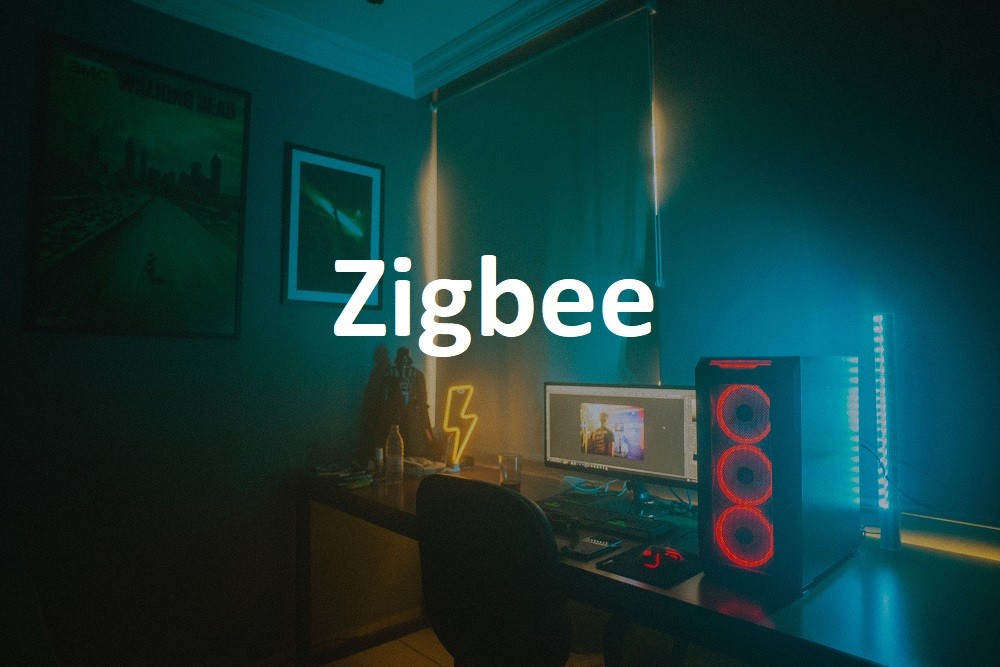[vc_row][vc_column][vc_column_text]Zigbee dimming, control and monitoring all in one! Zigbee is a digital lighting system that lets you control your lighting at the touch of a button. Enjoy energy-efficient lighting and the convenience of scheduling, automation and remote control. Get the most out of your lighting system with Zigbee! This article is a complementary article to the article on lighting control systems
How does Zigbee work?
Zigbee works over a mesh network, which means that each device on the network can communicate with other devices on the network. This allows a wide range of devices to be connected, even if they are not directly connected. Zigbee also uses a low-power communication protocol, which means that devices can operate for long periods on a single battery. Zigbee is based on the IEEE 802.15.4 standard and is designed to be easy to use, easy to implement and affordable.
What is Zigbee?
Zigbee dimming is a wireless technology that allows remote control and dimming of LED lights. It is based on the Zigbee wireless communication protocol, an open standard widely used in the Internet of Things (IoT).
Light and easy: Optimised for low power consumption to extend battery life and easy do-it-yourself use in consumer and commercial environments.
Proven, self-healing network: a self-organizing, self-healing network topology that scales to thousands of nodes, proven by nearly a decade of improvements and real-world applications.
Designed security: AES-128-bit message encryption and authentication, certificates and elliptic encryption protect personal data and device authentication from neighbouring networks.
Single Protocol: freedom to choose equipment and suppliers. The rich protocol provides a universal language that allows devices to work together regardless of brand.
2.4 and Sub-GHz PHY support: the Zigbee PHY supports both 2.4 and Sub-GHz frequencies to cover the widest range of installations and applications.
One of the main advantages of Zigbee is its ability to support a large number of devices on a single network. This makes it ideal for use in large lighting installations such as commercial buildings or industrial plants. The network is also highly reliable, with minimal latency and a high level of security.
Another advantage of Zigbee dimming is its compatibility with a wide range of devices. This includes not only LED lights but also other Zigbee-enabled devices such as thermostats and security cameras. This allows easy integration with other smart home devices, and users can control multiple devices with a single app or controller. You can easily find more Zigbee devices from various suppliers as there are many Zigbee manufacturers.
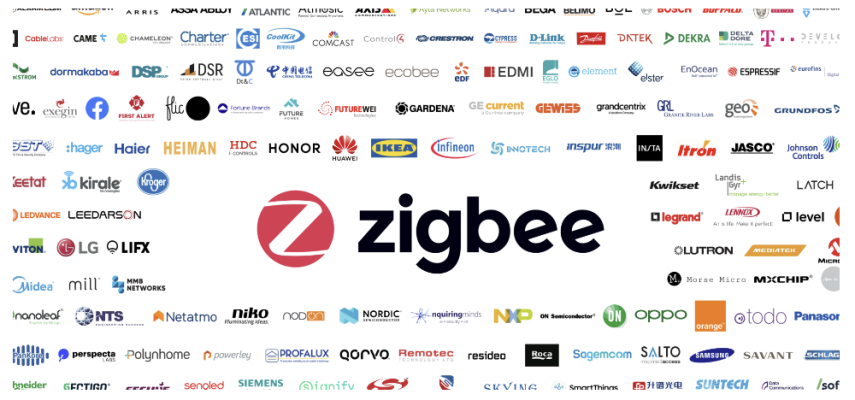
The Zigbee protocol is maintained and controlled by the Zigbee Alliance
Zigbee with a twist
Suppose you have lots of smart devices in your home, such as lights and door locks and thermostats. You want to control all these devices from one place, like a remote control. This is where the ZIGBEE system comes in!
ZIGBEE is like a secret language that smart devices speak to each other. Each device has a special computer, called a ZIGBEE chip, which helps it to understand and speak the ZIGBEE language.
Think of it like a big telephone game. You tell your friend a message, they tell the next person, who tells the next person, and so on until the message reaches the last person. In the same way, the ZIGBEE system sends messages from one device to another until the message reaches the device you want to control.
So when you use your smartphone or a special remote control to turn on the light, it sends a ZIGBEE message to the ZIGBEE system. The ZIGBEE system then sends a message from one device to another until it reaches the light you want to turn on. This is how the ZIGBEE system works!
Zigbee features
Zigbee dimming offers a number of advanced features designed to improve energy efficiency and reduce costs. For example, it supports automatic timing, which allows lights to be switched on and off at certain times of the day. It also supports daylight harvesting, adjusting the brightness of the lights according to the amount of natural light in the room.
Zigbee can control the colour scheme (RGB) and temperature control (CCT) of LED lights, but often both at the same time. (RGB+CCT).
Overall, Zigbee dimming is a powerful and versatile technology that offers many advantages for controlling and dimming LED lights. It is particularly suitable for large-scale installations and integration with other smart home devices
Using Zigbee
In most cases, Zigbee requires a special Zigbee hub or bridge to work, which can be an additional cost. In addition, the technology is still relatively new, so not all devices are fully compatible with it yet. One of the most well-known and supported hubs is the Philips HUE bridge. If you want to ensure almost 100% compatibility, choose Homeassistant and Conbee2 USB stick. However, it then requires your own computer to run the software all the time and maintain the software yourself. The spirit of engineering.
Zigbee devices can also be used without a hub if the devices to be connected support the Zigbee Touchlink protocol.

Zigbee installation
Zigbee dimming and lighting control can be installed on a single luminaire with a wireless pushbutton. Nothing else, no hubs, no fuss. But Zigbee is for much more than that. Zigbee lighting control devices are available for the following needs, here are some:
- Low voltage control 12-36V DC: these are installed between the existing driver and light.
- Mains control with dimming: a small TRIAC dimming support disc can be mounted behind the switch on the wall or next to the luminaire/luminaire group on the ceiling.
- Mains ON/OFF control: a small disc can be mounted behind the switch on the wall or next to the luminaire/luminaire group on the ceiling. Also e.g. control of a small electrical appliance.
- Mains power control ON/OFF to the socket: a plug-in receiver to be installed in the socket and a floor lamp or other electrical appliance connected to the socket in the appliance.
- Dimmable led drivers 24V: 24V for dimmable led lamps
- CCT led drivers 24V: 24V CCT, for temperature controlled led lamps
- RGBW led drivers 24V: 24V for RGBW led lights
Please note! ZIgbee RGBW driver cannot be used with CCT led strip even if the RGBW driver has 4 channels! This is because the ZIgbee protocol is very specific about which commands are given to which colour. So you can’t mix a warm white with a Red connector. In other words, always the right device for the job.
Pairing methods for Zigbee devices
The Zigbee protocol allows multiple ways to connect devices to each other. Here are 3 ways to do it:
Hub: all devices are taken to the hub and controlled by the phone app. Wireless buttons are also taken to the app and programmed there to do the things you want, such as triggering a particular situation. This method requires the buttons to be supported by the application, so you often have to use buttons made by the application manufacturer.
Find and Bind: All devices are brought into the hub and controlled by the phone app. Wireless buttons are also exported to the Zigbee network, but cannot be programmed there. The button and the device are paired using the find and bind method by launching it from both devices, allowing them to find each other on the network. The lighting situations stored in the button itself are available.
Touchlink: all devices can be taken to the hub and controlled by the phone app if desired. The wireless buttons are also brought into the Zigbee network if you want to use the app as well. But the buttons cannot be programmed there. The button and the device are paired using the Touchlink method by turning it on from both devices, dragging the devices side by side and they find each other. The lighting situations stored in the button itself are available. Touchlink therefore works even without a central unit.
The good and the bad of Zigbee
There are several advantages and disadvantages to using Zigbee dimming technology. No system is perfect and below are some of the aspects of ZIgbee:
The benefits of Zigbee:
Ease of use: the Zigbee dimmer is very easy to use, requiring no extra wiring or complicated installation process. It can be easily integrated into existing lighting systems, and users can control the brightness of their lights with an app on their smartphone or tablet.
Scalability: the Zigbee dimmer is highly scalable, so it can be used in small or large lighting systems. It can be used to control a single light or an entire building lighting system. Because it uses the Mesh architecture, you can expand your network almost without limits.
Low power consumption: the Zigbee dimming technology is designed to consume very little power, making it ideal for use in battery-powered devices. For example, a door sensor with batteries might last 2 years at a time.
Self-repairing network: the ZIgbee creates a Mesh network, so if the signal does not reach its destination directly, other devices will relay it.
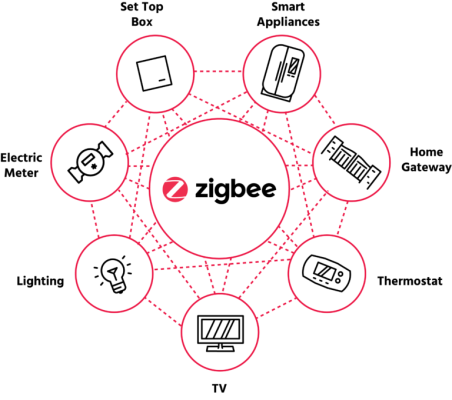
The downside of Zigbee:
Limited range: the range of Zigbee dimming is limited to 20 metres, which means it may not be suitable for use in large buildings or outdoors without repeaters or other Zigbee devices in between.
Interference: the Zigbee dimmer can be subject to interference from other wireless devices, which can cause lights to flicker or not work at all.
Compatibility: not all ZIgbee devices are made identical. It’s just that different brands of equipment don’t necessarily work together. This is a software issue, not a hardware issue.
History of Zigbee
Zigbee is a wireless communication standard that has been around for over a decade, but many people may not be aware of its existence or how it has evolved over the years. In this article, we look in detail at the history of Zigbee and how it has become a major player in the world of wireless networks.
Zigbeen origin
Zigbee was first developed by the Zigbee Alliance, a group of companies and organisations that came together in 2002 to create a wireless standard for low-power, low-cost devices. Zigbee’s goal was to create a wireless communication protocol that would be easy to use, easy to implement and affordable. This would allow it to be used in a wide range of devices from consumer electronics to industrial control systems.
The first version of Zigbee was released in 2004 and quickly gained popularity as a standard for wireless communication in low-power devices. Early versions of Zigbee were primarily used in home automation and control systems, such as light switches and thermostats.
Zigbee evolution
As Zigbee grew in popularity, the Zigbee Alliance began to expand the capabilities of the standard. In 2006, the Zigbee Pro feature set was introduced, adding support for larger networks and more complex applications. This made Zigbee more suitable for industrial control systems and other enterprise-level applications.
In 2008, the Zigbee Smart Energy profile was introduced, adding support for advanced energy management and control systems. This made Zigbee a popular choice for utilities and other organisations that needed to manage and monitor energy use.
In 2011, the Zigbee RF4CE (Radio Frequency for Consumer Electronics) profile was introduced, adding support for remote control applications such as TV remote controls and home theatre systems. This made Zigbee a popular choice among consumer electronics manufacturers.
The most significant entry by a major equipment manufacturer came in 2012, when Philips launched its own smart lighting system. Philips HUE.
The Zigbee Alliance has continued to develop the standard, and the latest version, Zigbee 3.0, was released in 2014. Zigbee 3.0 added support for greater security, improved network management and support for more devices.
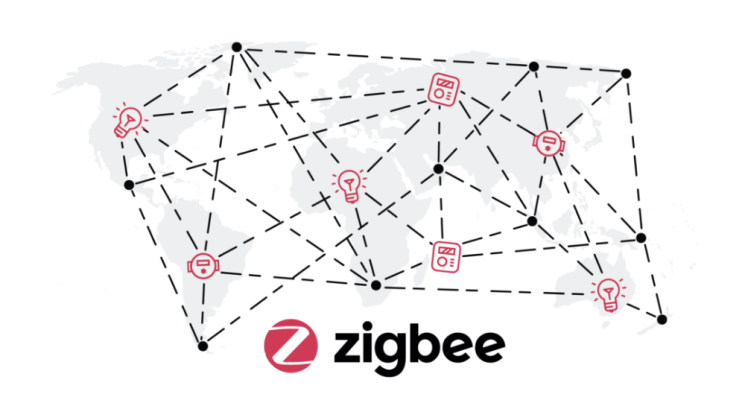
Zigbee today
Today, Zigbee is a widely used wireless communication standard, supported by a wide range of devices and applications. From home automation systems to industrial control systems and from consumer electronics to energy management systems.
In addition to consumer and industrial applications, Zigbee is also used in the Internet of Things (IoT) to connect different devices and systems. Zigbee’s low power requirements and relatively low cost make it an attractive alternative for IoT applications and it is expected to be a major player in this area in the coming years.
Zigbee has come a long way since its inception in 2002 and has become an important wireless communications standard for a wide range of devices and applications. From home automation to industrial control systems, Zigbee has proven to be a reliable and cost-effective wireless communication protocol that is suitable for a wide range of needs. As the IoT grows in popularity, Zigbee is likely to play an increasingly important role in connecting devices and systems.
How does Zigbee compare to other wireless communication standards?
Zigbee is similar to other wireless communication standards such as Z-Wave and Bluetooth Low Energy (BLE). There are differences:
- ZIgbee: A low-current, low data rate mesh network protocol for IoT devices.
- Z-wave: a low-current, low data rate mesh network protocol for home automation and IoT devices.
- BLE (Bluetooth Low Energy): a low-power, short-range wireless communication protocol commonly used in IoT devices and smartphones.
Matter
Zigbee is also involved in the development of the next wireless device standard. It’s called MATTER.
So by choosing Zigbee today, you’re safe for the future.
Major manufacturers such as Google, Apple, Zigbee, Philips, etc… have jointly released the Matter 1.0 protocol in 2022.
The first Matter consumer devices were presented at the CES in Las Vegas in January 2023.
For example, Philips has already updated its HUE hub to support Matter in autumn 2022!
Read more about Matter here
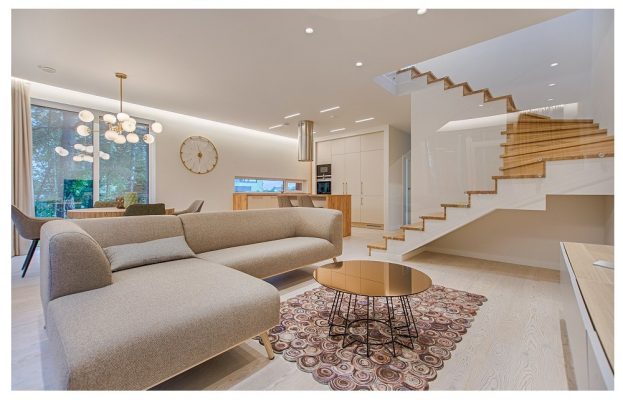
[/vc_column_text][/vc_column][/vc_row][vc_row][vc_column][vc_column_text]
Frequently asked questions about Zigbee
[/vc_column_text][vc_toggle title=”What is Zigbee dimming?”]Zigbee dimming is a feature that allows you to control the brightness of lights using a Zigbee-enabled device. This can be done using a smart home hub, such as Amazon Echo or Google Home, or a smartphone app.[/vc_toggle][vc_toggle title=”How does Zigbee dimming work?”]Zigbee dimming works by sending a signal from a Zigbee-enabled device to a dimmer switch or lamp. A dimmer switch or lamp then adjusts the brightness of the light accordingly.[/vc_toggle][vc_toggle title=”What types of lights can be dimmed using Zigbee?”]The Zigbee dimmer can be used with a wide range of lights, including incandescent, halogen and LED lights. However, it is important to check that your lights are compatible with Zigbee dimming before you buy a dimmer or lamp.[/vc_toggle][vc_toggle title=”What devices can control the Zigbee dimmer?”]Zigbee dimming can be controlled by a wide range of devices, including smart home hubs such as Amazon Echo or Google Home, and smartphone apps. The Zigbee dimmer can also be controlled by a physical dimmer or remote control.[/vc_toggle][vc_toggle title=”Can I schedule a Zigbee dimming?”]Yes, many Zigbee dimmer switches and lamps allow you to time the dimming of lights. This can be done with a smartphone app or a smart home hub.[/vc_toggle][vc_toggle title=”Can I control my Zigbee dimmer remotely?”]Yes, many Zigbee dimmer switches and lamps can be controlled remotely with a smartphone app or smart home hub. This means you can adjust the brightness of the lights even when you’re not at home.[/vc_toggle][vc_toggle title=”How do I set up a Zigbee dimmer?”]The process of setting up Zigbee dimming varies depending on the specific dimmer switch or lamp you use. Typically, however, it involves connecting a dimmer switch or lamp to a smart home hub or smartphone app.[/vc_toggle][vc_toggle title=”Is Zigbee dimming energy efficient?”]Yes, Zigbee dimming can be more energy efficient than traditional dimming methods, as it allows you to adjust the brightness of the lights to a precise level. This can help reduce energy consumption and save money on your electricity bill.[/vc_toggle][vc_toggle title=”How do I set up a Zigbee dimmer?”]The process of setting up Zigbee dimming varies depending on the specific dimmer switch or lamp you use. Typically, however, it involves connecting a dimmer switch or lamp to a smart home hub or smartphone app.[/vc_toggle][vc_toggle title=”Is Zigbee dimming compatible with other smart home devices?”]Many Zigbee dimmer switches and lamps are compatible with other smart home devices such as sensors and cameras. This allows you to integrate lighting with other aspects of your smart home.[/vc_toggle][vc_toggle title=”Are there additional costs associated with Zigbee dimming?”]In addition to the cost of a dimmer switch or lamp, Zigbee dimming may involve additional costs, such as subscription fees for certain smartphone apps or smart home hubs. It is important to check the possible additional costs before buying a Zigbee dimmer switch or lamp.[/vc_toggle][vc_toggle title=”What is Zigbee?”]Zigbee is a wireless communication standard designed for low-power and low-cost devices. It is based on the IEEE 802.15.4 standard and is designed to be easy to use, easy to implement and affordable. This makes it suitable for a wide range of devices from consumer electronics to industrial control systems.[/vc_toggle][vc_toggle title=”Can Zigbee dimming technology be used with other types of lights?”]Yes, Zigbee dimming technology can be used with many different types of lights, including incandescent, halogen and fluorescent.[/vc_toggle][vc_toggle title=”What is the maximum distance at which Zigbee dimming technology can work?”]The range of Zigbee dimming technology can vary depending on the devices and hardware used, but is usually around 20-50 metres.[/vc_toggle][vc_toggle title=”Is Zigbee dimming technology compatible with other wireless communication protocols?”]NO, Zigbee dimming technology is designed using its own protocol and not other wireless communication protocols such as Wi-Fi and Bluetooth.[/vc_toggle][vc_toggle title=”How do I adjust the brightness of my lights using Zigbee dimming technology?”]You can control the brightness of the lights using Zigbee dimming technology with an app on your smartphone or tablet, which you can download from the App Store or Google Play.[/vc_toggle][vc_toggle title=”Is Zigbee safe?”]Zigbee is designed with security in mind and uses a number of security features to ensure that communication is secure. However, as with any wireless communication protocol, it is important to take steps to ensure that the Zigbee network is secure. This includes using strong passwords, implementing encryption and keeping Zigbee devices up to date with the latest security patches.[/vc_toggle][/vc_column][/vc_row][vc_row][vc_column][vc_column_text]
Led dimming specialist
LedStore has been an expert in LED lighting and lighting design since 2010. We have our own product design, so our products are technically state-of-the-art. Products have quarantee for up to 7 years. We also carry out lighting maintenance.
We focus on temperature-controlled and high colour rendering lights, so they work brilliantly and last a long time. We make around. 500 lighting designs for our clients’ sites. Read more here or order a lighting design
We offer a service of custom-made LED strips, i.e. custom-made LED strips in aluminium profile. Also installed. Did you know? LedStore offers lighting design from 99 euros for the whole house!
Remember that we are always available to support you along the way, by email(myynti@ledstore.fi) and by phone (045 251 4510). As always, feel free to share photos of your own projects on social media at #ledstorefi IG and ledstore.fi FB. We love to see the cool things our LEDs do, and it helps to provide inspiration for those who are not sure about the power and awesomeness of LEDs. Did you know that we already have over 3500 pictures of our LED installations in our Gallery!
Photo gallery of Led lights:
Product gallery: pictures of products in different installation locations
Indirect light: indirect light in different spaces
Room-specific: Light in different rooms
References: complete houses that have been photographed[/vc_column_text][/vc_column][/vc_row]

